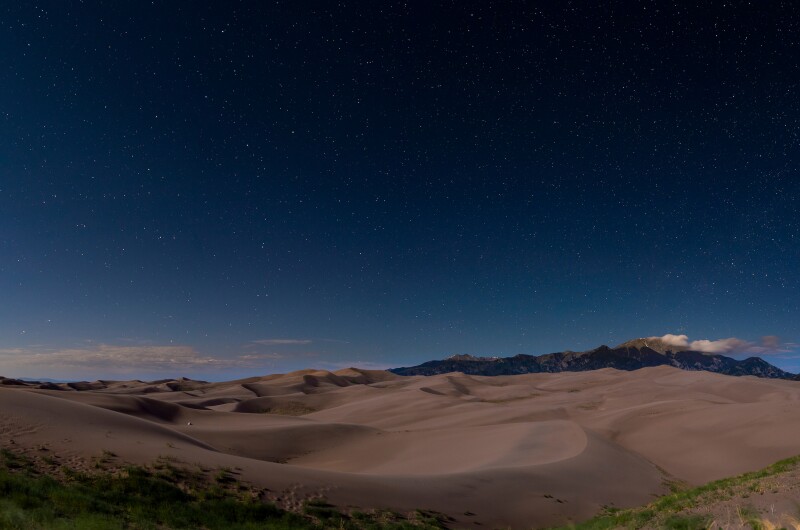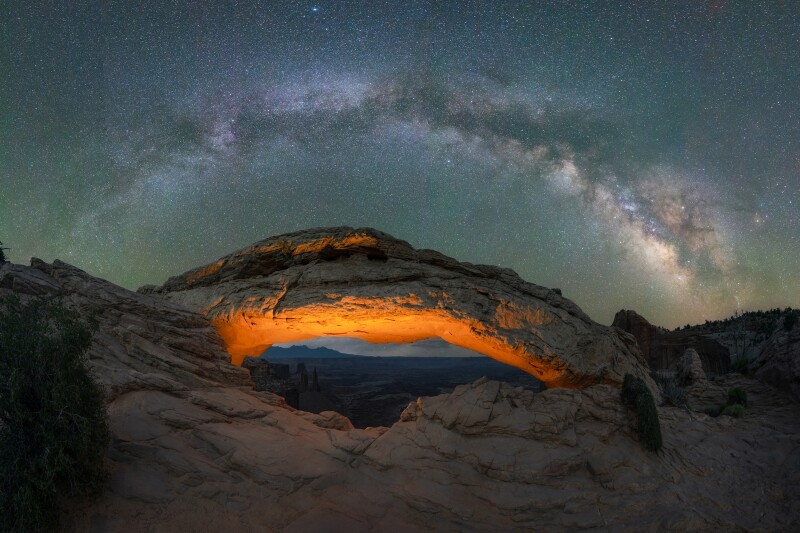Since the 1970s when astronomers first noticed the negative impact of light pollution, urban light has only gotten worse—by 10 percent a year in the past decade or so. Everything from the LEDs in lamp posts to neon signs on buildings is interrupting a rhythm of light and dark that is vital to the natural ecosystems of wildlife (to hide from predators or migrate) and to our sleep cycle.
To dim the man-made night lights, in 1988 astronomer David Crawford and physician Tim Hunter had a bright idea: They created a global dark-sky nonprofit called International Dark-Sky Association, which went on to become a movement in modifying and eliminating lighting sources to save energy and secure darkness. (Its new name is simply DarkSky.) The organization helped form dark-sky tourism, like encouraging stargazing and chasing the northern lights.
So whether you’re listening to an astronomy lesson, hiking up a mountain, or sitting silently on a blanket, to find the country’s darkest pockets, follow the stars to these nine U.S. national parks.
Pro tip: The darkest curtain typically falls on the new moon, so sync with NASA’s schedule. Watch the forecast for cloudless skies, and venture out at least an hour after sunset.
1. Grand Canyon National Park
Arizona
About a 90-minute drive from Flagstaff, Grand Canyon National Park provides after-hours seats to the Milky Way—which nearly 80 percent of Americans can no longer see because of light pollution. The Grand Canyon was recognized in 2019 as a Dark Sky Park, giving even more reason to add it to a bucket list. Enthusiastic stargazers gather annually for the park’s “Star Party” (the next one will be from June 21 to 28 in 2025) held at both the North and South Rims, featuring guest speakers and telescope viewing.
If you can’t make it to one of the national park’s Night Sky events, pack a red lamp for stargazing at Mather Point, Moran Point, Lipan Point, or Yavapai Point.
Where to stay
- Book now: Clear Sky Resorts; Yavapai Lodge
Get your glamp on in the desert at the sky domes of Clear Sky Resorts, a property 30 minutes south of the Grand Canyon that has amenities including food trucks and firepits. Alternatively, head to Yavapai Lodge within the park, which offers a Star Gazing Package and free Night Sky Talks about the James Webb Space Telescope and a star-viewing party at the Grand Canyon Village’s Market Plaza.

Some parks, like Death Valley National Park, are known for their stargazing possibilities.
Photo by Wilson Ye/Unsplash
2. Death Valley National Park
California
In addition to being the lowest and driest U.S. national park, Death Valley holds one of the highest darkness classifications by DarkSky. Situated between the Great Basin and the Mojave Desert, the iconic and massive park sees many starry nights. It hosts the annual Dark Sky Festival in partnership with NASA and is a stone’s throw from Panamint Valley’s California Dark Sky Festival, which will be held in 2024 from November 1 to 4. These are part of several emerging dark-sky celebrations, including Internationational Dark Sky Week and the World Wildlife Fund’s Earth Hour.
If you’re up for adventure, consider camping or bringing your RV or van to the Death Valley Starcamp (in the Panamint Valley) for the winter season. The campsite will include telescopes, giant chess sets lit by LEDs, and an outdoor arcade.
Where to stay
- Book now: The Inn at Death Valley
The Inn at Death Valley is a historic desert escape once frequented by such Hollywood stars as Marlon Brando and Carole Lombard. The elegant stone buildings have patios for stargazing.

Head over to Denali National Park, and you may see the aurora borealis.
FloridaStock/Shutterstock
3. Denali National Park and Preserve
Alaska
At Denali National Park, you can get physically closer to the stars than anywhere else on the continent: It has the highest summit in North America, at 20,310 feet. But you don’t necessarily need to make the harrowing journey to enjoy a star-studded night sky. The 6-million-acre park and preserve is full of gorgeous places to see the stars and the northern lights. Just be sure to come in the fall, winter, or spring. During the summertime, extended periods of sunlight (more than 20 hours a day) make it difficult to enjoy true darkness.
Where to stay
- Book now: Camp Denali
This property is one of the state’s best accommodation options, and it allows you to get to one of the deepest points in the park since a rockslide closed the park road at its halfway point until at least 2027. Guests can enjoy guided hikes in the daytime; keep an eye out for majestic animals like moose and caribou.

According to the NPS, the Milky Way is clearest in the evening sky during late summer and fall.
Photo by Gunnar Rathbun/Shutterstock
4. Great Sand Dunes National Park and Preserve
Colorado
Take your dark sky viewing game to one of the largest sandboxes in North America—this national park has the tallest dunes on the continent at 750 feet. Surrounded by the Sangre de Cristo Mountains, these 30 square miles of dunes have origins tracing back millions of years, when moving tectonic plates created a valley. Melted ice and snow brought along sediments accumulated in the valley to form a lake (called Lake Alamosa), which started drying out 440,000 years ago, eventually turning into the dunes visitors enjoy today. For the best views of the Milky Way, NPS advises travelers to venture during the early morning hours of spring or evening hours from mid-summer to autumn. Once you’re there, it’s just you and the stars—and maybe an owl or camel cricket.
Where to stay
- Book now: Zapata Ranch
Take a horseback ride during the day over the dunes and stargaze before hitting the hay at the nearby Zapata Ranch, a historic lodge built as a ranch homestead. It may be the last time you’ll get the opportunity—the 2024 season will be the last that it’s offering stays.

Crater Lake National Park’s namesake lake is one of the best spots to catch the stars.
Photo by Colin D. Young/Shutterstock
5. Crater Lake National Park
Oregon
This national park‘s natural wonder transformed from mountain peak to lake 7,700 years ago after a massive volcanic eruption. On the edge of the Oregon Dark Sky Sanctuary, its elevation at 6,178 feet makes it a perfect spot for stargazing. Plus, the crystal clear waters from the lake (which is also the deepest in the country) serve as a mirror for the stars in the night sky.
Where to stay
- Book now: Crater Lake Lodge
Nestled between cliffs, the 71-room Crater Lake Lodge delivers a vast stretch of dark sky right there on the lake. Plus, the stay is a convenient base for daytime excursions like biking the 33-mile Rim Drive, as well as hiking through parts of the Pacific Crest Trail.

Acadia National Park has some of the darkest skies in the Northeast.
Photo by Harry Collins Photography/Shutterstock
6. Acadia National Park
Maine
It’s no surprise that New England’s biggest state possesses the largest area of naturally dark sky east of the Mississippi River. Also home to New England’s only national park, Acadia allows hiking, biking, and vehicle access (for a few months a year) to the summit of Cadillac Mountain for summer stargazing—and catching the northern lights, if you’re lucky. There is no shortage of star-studded stops on these trails running right along the Atlantic, including Jordan Pond, Seawall, Ocean Path, and Sand Beach.
Where to stay
- Book now: Under Canvas Acadia
Get cozy in a chic safari-style canvas tent on the waterfront at the 2021-opened Under Canvas Acadia. Around a 35-minute drive away from Acadia National Park and situated on 100 acres of land, the property gets visitors away from the crowds for unbeatable stargazing.

Thanks to its remote location, Big Bend National Park offers some of the darkest skies in the lower 48.
Photo by Wisanu Boonrawd/Shutterstock
7. Big Bend National Park
Texas
Everything is bigger in Texas—including the starry nights at Big Bend National Park. Ringing in at 800,000 acres, the park has hiking trails connecting the mountains and desert. Away from the bright lights, on the “Big Bend” of the Rio Grande boundary between Texas and Mexico, this isolated International Dark Sky Park is one of the most remote in the country.
Where to stay
- Book now: Summit at Big Bend
Drift off in a glamping dome or a cave room carved into the side of Tres Cuevas Mountain on this 1,000-acre desert property, known as Summit at Big Bend, with modern amenities like plush linens and air conditioning.

The proximity of Canyonlands to other national parks makes for a great road trip centered around stargazing.
Photo by Mike Ver Sprill/Shutterstock
8. Canyonlands National Park
Utah
The canyons and buttes that wrap around the Colorado River are the ultimate scenic backdrop to the stars. The Canyonlands’ 337,598 acres encompass one of the most beautiful dark sanctuaries out there with rock formations framing the night sky. If you feel like making a road trip of it, follow the stars to other Dark Sky Parks in the area, including Arches National Park, Hovenweep National Monument, and Natural Bridges National Monument.
Where to stay
- Book now: Ulum
Within a 40-minute radius of these natural rock formations, canyons, and arches, is the Ulum Moab and its luxury glamping tents.

The park’s Joshua trees add to the unique landscape of this stargazing destination.
Photo by Chones/Shutterstock
9. Joshua Tree National Park
California
Slightly larger than the state of Rhode Island, Joshua Tree National Park is a showstopper with bighorn sheep and hundreds of species of birds fluttering in and out of the grasslands and rocky outcroppings. For the park’s darkest skies, head down Pinto Basin Road and look up between Cholla Cactus Garden and Cottonwood. And don’t forget about the park’s annual Night Sky Festival, held at the Sky’s the Limit Nature Center and Observatory, right outside the park’s north entrance.
Where to stay
- Book now: AutoCamp
A 10-minute drive from Joshua Tree National Park, AutoCamp Joshua Tree is home to souped-up Airstreams and suites with outdoor patios, plus community firepits, complimentary mountain bikes, a spa and plunge pool, and a new moon sunbath excursion with sound therapy for next-level rest and relaxation.

Flagstaff, Arizona was recognized as the world’s first International Dark Sky City in 2001.
Photo by Will Alpert/Shutterstock
Bonus: Sunset Crater Volcano, Walnut Canyon, and Wupatki National Monuments
Arizona
Take your shot at stargazing in the original International Dark Sky Place: Flagstaff, Arizona. The birthplace of the stargazing movement is now home to observatories and astronomy centers. Follow a 34-mile loop connecting these three places—AutoCamp Joshua Tree, Walnut Canyon, and Wupatki national monuments, jointly managed by the U.S. National Park Service—to Native American ruins, red rocks, and painted desert vistas.
Where to stay
- Book now: The Bonito Campground
The Bonito Campground gets its name from the Bonito Lava Flow, which spread across the land 900 years ago. This campground inside the Coconino Forest offers 44 sites with tables, fire rings and cooking grills, and flush-type toilets.
This article originally appeared in 2023; it was most recently updated on July 11, 2024, to include current information.











